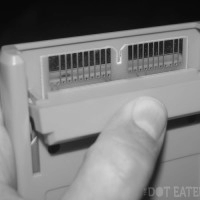 Today, we take it for granted that a video game system will be able to run many different games. Whether it’s through cartridges, cards, disks, or even just downloads, every device that is considered a proper gaming console (and many others) will have a library that increases over the lifespan of the system. However, this was not always the case. The Magnavox Odyssey, generally recognized as the first home video game system, came out in 1972, while the first console to use cartridges, the Fairchild Channel F, did not come out until 1976. The Odyssey did allow one to put in jumper cards, which altered the contacts on the circuit board to create different variations of the basic Pong-esque game you could play, but that was the extent to which the player could alter the game.
Today, we take it for granted that a video game system will be able to run many different games. Whether it’s through cartridges, cards, disks, or even just downloads, every device that is considered a proper gaming console (and many others) will have a library that increases over the lifespan of the system. However, this was not always the case. The Magnavox Odyssey, generally recognized as the first home video game system, came out in 1972, while the first console to use cartridges, the Fairchild Channel F, did not come out until 1976. The Odyssey did allow one to put in jumper cards, which altered the contacts on the circuit board to create different variations of the basic Pong-esque game you could play, but that was the extent to which the player could alter the game.
(Side note: The Odyssey’s development actually predates Pong, but Pong pretty much beat it to market. Developers of both have been known to get grumpy if you ask about how exactly that went down [1].)
This style of system was typical of the period – Atari’s Home Pong, in 1975, was much the same [2], and a whopping 75 companies said they would release a home system that played “tennis” in 1976. These systems were quite successful – the Odyssey sold 100,000 copies, Home Pong sold 150,000 in its first year [3], and Coleco’s Telestar sold more than $100 million worth of units [4]. Even Nintendo sold single-game systems, the Color TV Game 6 and Color TV Game 15, both released in 1977 [5].
If single-game systems were doing so well, why did Fairchild decide to do something else? A large part of it was advancing technology. Most, if not all, of the single-game systems were a single (complicated) circuit. The release of Intel’s 4004 microprocessor in 1971 (and its successors, the 8008 in 1972 and 8080 in 1974) allowed games to be done with software rather than hardware. Therefore, changing games only required changing the memory, not the entire circuit. In 1974, Wallace Kirschner of Alpex realized that there was a potential market for a system with software games, and started development. But Alpex knew that they were not big enough to be able to finance such a game on their own, and in 1975 approached semiconductor manufacturers. Fairchild thought it was interesting, and decided to help. Jerry Lawson, an engineer at Fairchild, joined up with Kirschner and Lawrence Haskel at Alpex to build the system.
 Figure 1: The contacts on the outside of a Fairchild Channel F game cartridge.
Figure 1: The contacts on the outside of a Fairchild Channel F game cartridge.
However, as they put it together, they realized that changing the memory out was a delicate operation that the typical consumer would not be comfortable doing. In order to make something that would be accessible to the layperson, they brought on an industrial designer, Nick Talesforce. He realized that there already was something similar in the homes of many consumers – 8-track tapes, the predecessor to cassettes. He mimicked their approximate size for the memory cartridges, but added ridges to make it easier to add and take out – a convention that has been followed by pretty much all cartridge systems that have come and gone.[6]
 Figure 2: The Fairchild Channel F game console with a game cartridge.
Figure 2: The Fairchild Channel F game console with a game cartridge.
While the Channel F made quite the splash when it was released in 1976, it ultimately did not do very well, selling 350,000 units in three years. Atari, which released its own cartridge-based system, the Atari 2600 (a.k.a. the Video Computer System), in 1977, sold millions in the same time period.6 The difference? Games. Atari was already very established in the arcade business, and formed an entire division to provide new games to its console on an ongoing basis. Compared to Fairchild, which had made the system as a way of selling microprocessors, Atari knew that it could make more money off of new games for the system, giving them an incentive to make games that people would want to buy. And that’s a lesson that has proved to be true over the decades since those early days of video gaming. People follow the consoles for fun games, not the biggest technical innovations.
Citations
[1] www.vintagecomputing.com/index.php/archives/404
[2] The Ultimate History of Video Games, page 87
[3] The Ultimate History of Video Games, page 94
[4] The Ultimate History of Video Games, page 96
[5] iwataasks.nintendo.com/interviews/#/clubn/game-and-watch-ball-reward/0/0
[6] www.fastcompany.com/3040889/the-untold-story-of-the-invention-of-the-game-cartridge
[7] The Ultimate History of Video Games, page 180